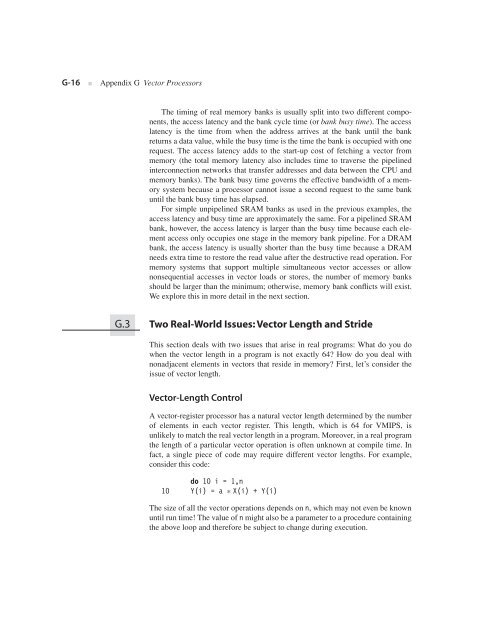Appendix G - Clemson University
Appendix G - Clemson University
Appendix G - Clemson University
Create successful ePaper yourself
Turn your PDF publications into a flip-book with our unique Google optimized e-Paper software.
G-16 ■ <strong>Appendix</strong> G Vector Processors<br />
The timing of real memory banks is usually split into two different components,<br />
the access latency and the bank cycle time (or bank busy time). The access<br />
latency is the time from when the address arrives at the bank until the bank<br />
returns a data value, while the busy time is the time the bank is occupied with one<br />
request. The access latency adds to the start-up cost of fetching a vector from<br />
memory (the total memory latency also includes time to traverse the pipelined<br />
interconnection networks that transfer addresses and data between the CPU and<br />
memory banks). The bank busy time governs the effective bandwidth of a memory<br />
system because a processor cannot issue a second request to the same bank<br />
until the bank busy time has elapsed.<br />
For simple unpipelined SRAM banks as used in the previous examples, the<br />
access latency and busy time are approximately the same. For a pipelined SRAM<br />
bank, however, the access latency is larger than the busy time because each element<br />
access only occupies one stage in the memory bank pipeline. For a DRAM<br />
bank, the access latency is usually shorter than the busy time because a DRAM<br />
needs extra time to restore the read value after the destructive read operation. For<br />
memory systems that support multiple simultaneous vector accesses or allow<br />
nonsequential accesses in vector loads or stores, the number of memory banks<br />
should be larger than the minimum; otherwise, memory bank conflicts will exist.<br />
We explore this in more detail in the next section.<br />
G.3 Two Real-World Issues: Vector Length and Stride<br />
This section deals with two issues that arise in real programs: What do you do<br />
when the vector length in a program is not exactly 64? How do you deal with<br />
nonadjacent elements in vectors that reside in memory? First, let’s consider the<br />
issue of vector length.<br />
Vector-Length Control<br />
A vector-register processor has a natural vector length determined by the number<br />
of elements in each vector register. This length, which is 64 for VMIPS, is<br />
unlikely to match the real vector length in a program. Moreover, in a real program<br />
the length of a particular vector operation is often unknown at compile time. In<br />
fact, a single piece of code may require different vector lengths. For example,<br />
consider this code:<br />
do 10 i = 1,n<br />
10 Y(i) = a ∗ X(i) + Y(i)<br />
The size of all the vector operations depends on n, which may not even be known<br />
until run time! The value of n might also be a parameter to a procedure containing<br />
the above loop and therefore be subject to change during execution.

















